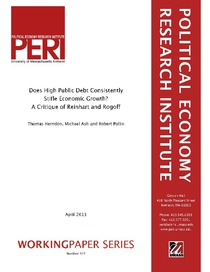Does high public debt consistently stifle economic growth? A critique of Reinhart and Rogoff
"We replicate Reinhart and Rogoff (2010a and 2010b) and find that coding errors, selective exclusion of available data, and unconventional weighting of summary statistics lead to serious errors that inaccurately represent the relationship between public debt and GDP growth among 20 advanced eco...
| Main Authors: | , , |
|---|---|
| Institution: | ETUI-European Trade Union Institute |
| Format: | TEXT |
| Language: | English |
| Published: |
Amherst
2013
University of Massachusetts |
| Subjects: | |
| Online Access: | https://www.labourline.org/KENTIKA-19397975124911151579-Does-high-public-debt-consiste.htm |
| Summary: | "We replicate Reinhart and Rogoff (2010a and 2010b) and find that coding errors, selective exclusion of available data, and unconventional weighting of summary statistics lead to serious errors that inaccurately represent the relationship between public debt and GDP growth among 20 advanced economies in the post-war period. Our finding is that when properly calculated, the average real GDP growth rate for countries carrying a public-debt-to-GDP ratio of over 90 percent is actually 2.2 percent, not −0.1 percent as published in Reinhart and Rogoff. That is, contrary to RR, average GDP growth at public debt/GDP ratios over 90 percent is not dramatically different than when debt/GDP ratios are lower. We also show how the relationship between public debt and GDP growth varies significantly by time period and country. Overall, the evidence we review contradicts Reinhart and Rogoff’s claim to have identified an important stylized fact, that public debt loads greater than 90 percent of GDP consistently reduce GDP growth." |
|---|---|
| Physical Description: | 25 p. Digital |

